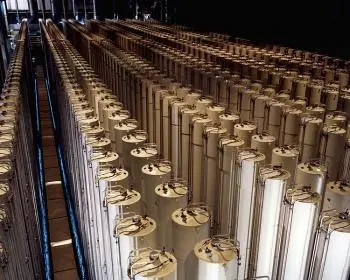
Enriched uranium is uranium that has undergone a technological process to increase the proportion of the isotope uranium-235. As a result, natural uranium is divided into enriched uranium and depleted uranium.
Natural uranium contains three isotopes of uranium:
-
Uranium-238 (99.2745%)
-
Uranium-235 (0.72%)
-
Uranium-234 (0.0055%).
The uranium-238 isotope (with 238 neutrons) is a relatively stable isotope, incapable of generating an independent nuclear chain reaction, unlike the fissile isotope U-235.
Currently, uranium-235 is the main fissile material used in nuclear power plants and in some types of nuclear weapons such as the atomic bomb. However, for many applications, the proportion of fissile uranium (U-235) in natural uranium is small and fuel preparation generally includes a uranium enrichment process.
What is uranium enriched for?
Enriched uranium favors nuclear chain reactions within atomic reactors.
The nuclear chain reaction implies that at least one neutron released during a fission reaction hits another atom and generates another fission reaction. This requires that the uranium concentrate be compact enough to increase the probability that the released neutron will find a next uranium atom.
On the other hand, as reactions occur within nuclear reactors, uranium-235 is wasted reducing the likelihood of a collision.
Uranium enrichment is an inexpensive solution to increase the proportion of uranium-235 in nuclear fuel.
Enriched uranium is also used in nuclear weapons. In the design of the atomic bomb it is required that in the extremely short time of a nuclear explosion, the maximum number of uranium-235 atoms find its neutron, fission and release energy.
Classification according to the degree of enrichment of uranium
Uranium can be classified into:
1. Natural
Natural uranium with a uranium-235 content of 0.72% is used in some power reactors (eg Canadian CANDU), in reactors producing plutonium (eg A-1).
2. Little enriched
Uranium with a uranium-235 content up to 20% is called low enriched. Uranium with 2-5% enrichment is now widely used in power reactors around the world. Uranium enriched up to 20% is used in research and experimental reactors.
3. Highly enriched
Uranium with a uranium-235 content above 20% is called highly enriched or weapon.
Highly enriched uranium can be used in a thermonuclear weapon.
Furthermore, highly enriched uranium is used in nuclear power reactors with little or no refueling, for example in spacecraft reactors.
4. Impoverished
Depleted uranium has 0.1-0.3% uranium-235 content. It is generally the residue from the uranium enrichment process.
This material is widely used as cores for armor-piercing projectiles due to the high density of uranium and low cost.
In the future, it is proposed to use depleted uranium in fast neutron reactors.
How is uranium enriched?
The enrichment process begins with the uranium cleaned of impurities.
Many methods of isotope separation are known. Most of the methods are based on different masses of atoms of different isotopes: 235 is slightly lighter than 238. This manifests itself in different inertia of the atoms.
Electromagnetic methods and gas diffusion are based on this principle.
Today almost all uranium enrichment facilities are based on gas centrifugation. Uranium is in the form of uranium hexafluoride. After enrichment, chemical plants transform uranium hexafluoride into uranium dioxide.